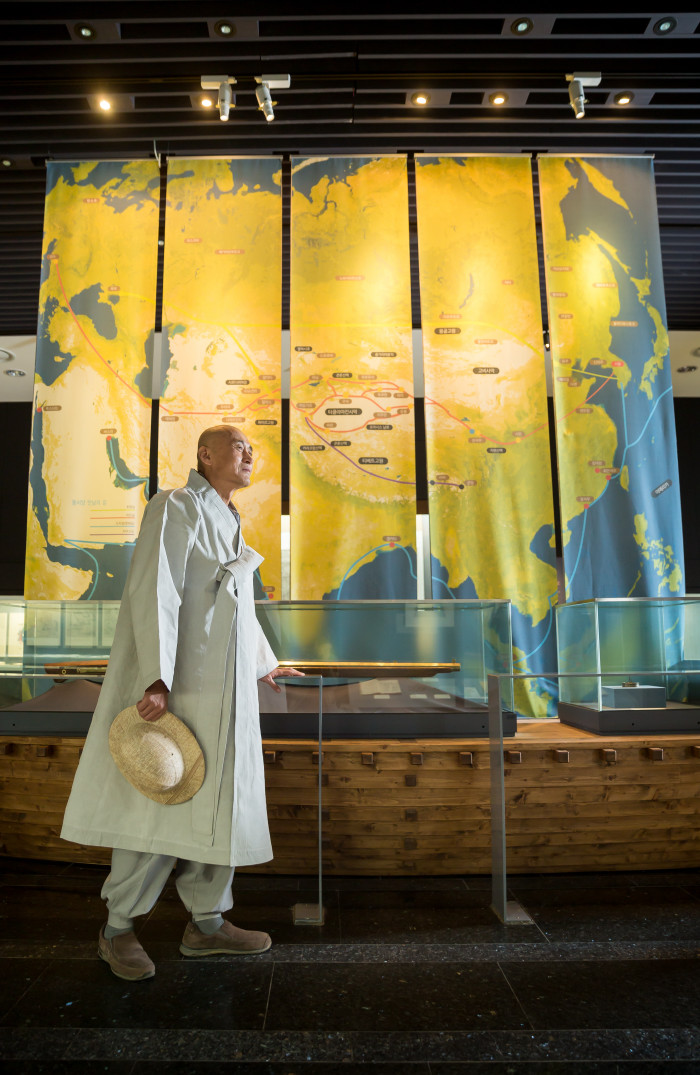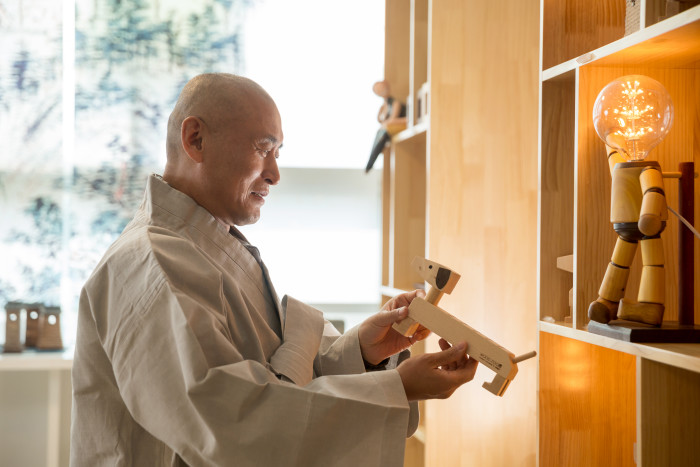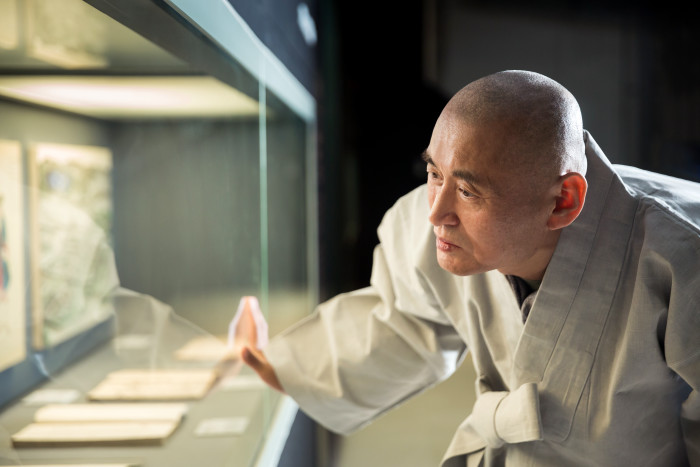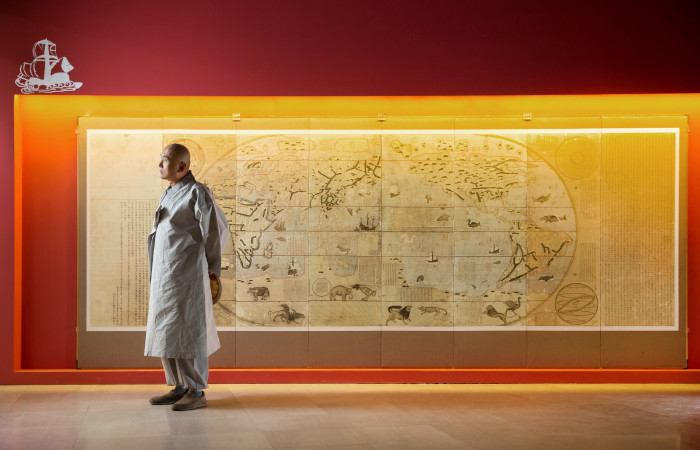GGC
Finding a connection between Dasan and Sujongsa Temple
May 4, 2018 / Buddhist monk Dongsan Sunim of Sujongsa Temple

The paths to Sujongsa Temple are very steep. The paths are so precipitous and narrow that the trail is difficult even for experienced climbers. However, the view of the river and mountains from Sujongsa Temple is magnificent. Sujongsa Temple is a very popular tourist destination for its beautiful scenery. In addition, Sujongsa Temple has a special bond with some figures. Haneum Yi Deok-hyeong (1561-1613), well known for Oseong and Haneum, and Dasan Jeong Yak-yong (1762-1836) visited Sujongsa Temple often. You can still easily find their traces in the temple. Do-ol also cherishes Sujongsa Temple.
Do-ol said that the name of Sujongsa Temple kept showing up when he was studying Silhak. So he wanted to visit the temple someday, and when he finally paid us a visit, he came and talked about Buddhist monk Choui Sunim a lot. He said Buddhist monk Choui Sunim and Dasan have a special connection. It is said that the monk came here from Gangjin when Dasan returned after being released from exile. At the time, the monk stayed here. I told Do-ol that I would let him use one of our rooms so he could visit us frequently, but he said he didn’t want to go outside when he was reading a book. He said he barely left his house to visit the temple. But he really liked Sujongsa Temple.
Sujongsa Temple and Dasan have a deep connection. Chocheonsasisa, Dasan's poetic works containing 13 series of poems written in 1786, includes the poem entitled Looking at Snow at Sujongsa Temple (水鍾山賞雪詞云). After Dasan was released from exile and came back to Gangjin, his sons and Buddhist monk Choui Sunim looked around Sujongsa Temple with the hospitality of Dasan and wrote some poems. The paintings and writings still remain. Sujongsa Temple has a special connection with Silhak scholars.


Sujongsiyucheop
In the fall of 1830, Dasan's two sons, Jeong Hak-yeon and Jeong Hak-yu, and Choui Sunim who met Dasan during his exile in Dangjin looked around Sujongsa Temple and exchanged poems. Their poems can be found in Sujongsiyucheop. Dasan, Hong Hyeon-ju, Bak Bo-yeong and Yi Man-yong wrote some articles and Hong Hyeon-ju worked on paintings. Their writings and paintings describe Ungilsan Mountain and their sightseeing realistically. This work shows that Dasan interacted with other scholars late in his life.
Nangpung and Hyeonpo are hazy. (縹緲閬風縣圃)
Jade-green trees and silver folding screens are standing. (周遭玉樹銀屛)
Mountain peaks touching the sky are black. (天近峯巒似黑)
Only the flowing river is blue. (水逢湍瀬暫靑)
- 2010 Special Exhibition Catalogue "Dasan's Unofficial Writing, Yeoyudangjip," Jeongmin, Theses of Special Exhibition, p. 219
Dasan wrote this poem at the age of 25. Nangpung and Hyeonpo mean the world of Xian (Taoist hermits with miraculous powers). Besides his depiction of the snowy view of Sujongsa Temple as the world of Xian, he found black, blue, and jade green in the snow-covered mountain which demonstrates his keen sense of discernment. There would certainly be a reason why his lifelong works did not lose color even after 200 years but only became more valuable as time went by.

Positive energy of people in a certain space makes you feel familiar with a strange place. On the day I visited Sujongsa Temple to request an interview, Buddhist monk Dongsan Sunim served me the lotus leaf tea that he cherished. He welcomed a stranger with his favorite tea, which made me think of his generosity as that of Buddha’s. I can still feel the deep fragrance of lotus leaf tea roasted by the monk himself.
I have the same family name as Jeong Yak-yong, so he is technically one of my ancestors. (laughing) Dasan had a connection with Buddhist monk Choui Sunim in terms of religion and he had a connection with Sujongsa Temple in terms of space. Furthermore, considering the blood heritage that I have in common with Dasan (laughing), I have a very special connection with him.

Buddhist monk Dongsan Sunim looked around the Museum of Silhak from the Museum Shop. He barely goes to the movies once a year; considering that he is easily surprised by even simple items such as portable chargers, he is not the savviest person of the world. He responded to cute items in the Museum Shop in an unexpected manner.
Wow, they are amazing. How did they make such items? It looks so real.
He checked out wooden Jack Russel Terriers and showed interest in pottery apples and child-shaped ceramic figures like those of 7-year-olds. But he simply passed by the tile-roofed house miniatures because they appeared exactly the same as where he had lived. He looked around from Exhibition Hall 1 to Exhibition 3 meticulously and asked some questions. When he looked at New Kunyu Wanguo Quantu, he found that all the ships had the Buddhist symbol (卍, temple) on the flags.

All the ships have the Buddhist symbol, or man (卍). How did Matteo Ricci know the Buddhist symbol (卍)? That is amazing. This is the map restored from a picture in Bongwonsa Temple. At that time I was the vice chief Buddhist monk of Bongwonsa Temple. So I heard the story of Kunyu Wanguo Quantu from the former Head of the Museum of Silhak Kim Si-eop in person.
It was for missionary work that Mateo Ricci drew a map of the world and gave it to China's emperor. So the ships originally had cross flags, not flags with the Buddhist symbol. It is said that he changed the cross flags to flags with the Buddhist symbol because crosses symbolized execution and death in China. Flags with Buddhist symbol in the map are so small that it is difficult to find. Buddhist monk Dongsan Sunim was one of those who could discern the small images.
It is really great here. I visited this museum a couple of times before, but I have never looked around so meticulously as I’m doing right now. So it feels as if I’m discovering something new today. I think it would be better if this interesting Silhak could be practically applied to our daily lives. Ho Chi Minh is one of the most respected figures in Vietnam. I heard that his role model was Dasan. I'm not sure whether it is true or not; I hope the Museum of Silhak confirms that. If the stories of Dasan or Silhak are reproduced through well-known figures, the Museum of Silhak could become more familiar to us.
The story about Ho Chi Minh and Dasan was confirmed by the Museum of Silhak in 2010. “There was a myth that Ho Chi Minh had once said, ‘Dasan's books could be divided into legal books and illegal books.’ Some people said that Ho Chi Minh read Gyeongseyupyo. After a review of Dasan's unofficial book, it was found that the myth was completely unfounded.” (2010 Special Exhibition Catalogue "Dasan's Unofficial Writing, Yeoyudangjip," p. 123.) The myth that Ho Chi Minh had admired Dasan may have been a legend created out of people's wishes and expectations.
As his wish, the Museum of Silhak is finding a way to become closer to people in a practical way, instead of remaining a stagnant ideology or a taxidermied area of study. A place where anyone can and would want to visit whenever he or she faces limitations in real life, and a place where anyone can organize his or her thoughts, seek realistic alternatives, and gain insight into their lives in the long run with a far-reaching perspective - this is the ultimate goal of the Museum of Silhak.

<Copyright(c)2002 GGC All rights reserved.>
information
Museum of Silhak/ Newsletter Issue 82
Special Talk Talk/ Buddhist monk Dongsan Sunim of Sujongsa Temple
Written by/ Kim Su-mi (Planning & Operation Team, Museum of Silhak)
Address/ 16, Dasan-ro 747beon-gil, Joan-myeon, Namyangju-si, Gyeonggi-do
Inquiries/ 031-579-6000
Museum of Silhak Website/ http://silhak.ggcf.kr
Operation Hours/ 10:00-18:00
Closed/ Every Monday
- Writer
- About
You might like
Location around
The person who lives the moment
September 1, 2018 - December 31, 2018 / Actress Seo Yi-suk
Spiral desire built by the rectangular life
Actor Jung Dong-hwan
Namyangju_Neungnae Station
With Baraboda, Number Nine
THE FORMATION AND DEVELOPMENT OF KOREAN SILHAK, ASTRONOMY AND GEOGRAPHY
3. Silhak and science (astronomy and geography)